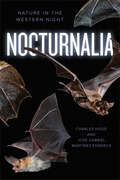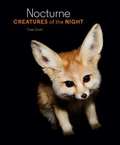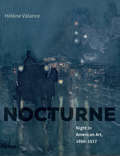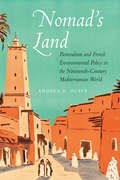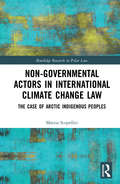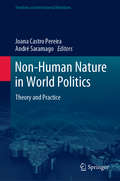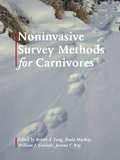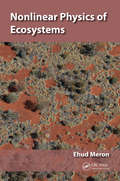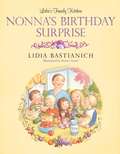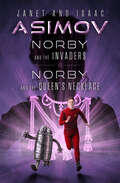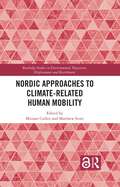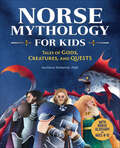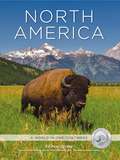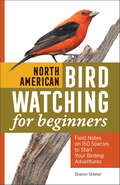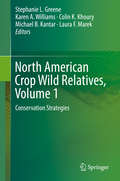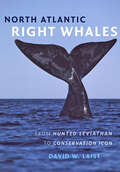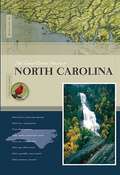- Table View
- List View
Nocturnalia: Nature in the Western Night
by Charles Hood José Gabriel Martínez-FonsecaDon’t be afraid of the dark: grab a flashlight and rediscover your sense of adventure!Darkness is something humans strive to keep at bay, but under the glow of twilight a nocturnal universe stirs to life. Nightshade blossoms bloom, javelinas parade down city streets, fox eyes gleam under the cover of the forest, and tiny sparrows fly incredible distances, guided by the stars. Naturalist Charles Hood and bat biologist José Gabriel Martínez-Fonseca unravel these enigmas in Nocturnalia, inviting readers on an environmental romp through the wonders of the Wild West. Their sundown dispatches, featuring over 100 photographs from California and the American Southwest, take us from the astronomical canopy overhead, to the flora that unfurl under moonshine, to the creatures that go bump in the night. With practical tips for the budding nighttime naturalist, the authors invite citizen scientists of all stripes to expand our knowledge of this final frontier and our understanding of life on Earth. Exploring the evolutionary adaptations of owls, bats, and other nightlife animals; the natural history of nighttime plants; and the celestial patterns that regulate this after-dark kingdom, Hood and Martínez-Fonseca lift their lanterns to illuminate the exquisite and intricate inner workings of nature after nightfall.
Nocturne
by Traer ScottWhether fierce, cuddly, startling, mysterious, or some indefinable combination of all of the above, nocturnal animals never fail to fascinate. In Nocturne: Creatures of the Night, celebrated animal photographer Traer Scott takes the viewer on a journey through nighttime in the animal kingdom, revealing some of nature's most elusive creatures. Bats, big cats, flying squirrels, tarantula, owls, kangaroo mice, giant moths, sloth, several species of snakes, and a Madagascar hissing cockroach are only a few of the animals illuminated in these lushly detailed portraits. Seventy-five full-color photographs of forty different species are accompanied by informed but accessible descriptions of each animal's habits and habitats, and an introduction provides personal insight into how Scott captures her astonishing images. Nocturne is a compelling view of the rarely seen darkness dwellers who populate the night.
Nocturne: Night in American Art, 1890-1917
by Jane Marie Todd Hélène ValanceA beautifully illustrated look at the vogue for night landscapes amid the social, political, and technological changes of modern America The turn of the 20th century witnessed a surge in the creation and popularity of nocturnes and night landscapes in American art. In this original and thought-provoking book, Hélène Valance investigates why artists and viewers of the era were so captivated by the night. Nocturne examines works by artists such as James McNeill Whistler, Childe Hassam, Winslow Homer, Frederic Remington, Edward Steichen, and Henry Ossawa Tanner through the lens of the scientific developments and social issues that dominated the period. Valance argues that the success of the genre is connected to the resonance between the night and the many forces that affected the era, including technological advances that expanded the realm of the visible, such as electric lighting and photography; Jim Crow–era race relations; America’s closing frontier and imperialism abroad; and growing anxiety about identity and social values amid rapid urbanization. This absorbing study features 150 illustrations encompassing paintings, photographs, prints, scientific illustration, advertising, and popular media to explore the predilection for night imagery as a sign of the times.
Nomad Century: How Climate Migration Will Reshape Our World
by Gaia Vince“The MOST IMPORTANT BOOK I imagine I'll ever read.”—Mary RoachFROM AN AWARD-WINNING SCIENCE JOURNALIST comes an urgent investigation of environmental migration—the most underreported, seismic consequence of our climate crisis that will force us to change where—and how—we live.“An IMPORTANT and PROVOCATIVE start to a crucial conversation.” —Bill McKibben“We are facing a species emergency. We can survive, but to do so will require a planned and deliberate migration of a kind humanity has never before undertaken. This is the biggest human crisis you’ve never heard of.”Drought-hit regions bleeding those for whom a rural life has become untenable. Coastlines diminishing year on year. Wildfires and hurricanes leaving widening swaths of destruction. The culprit, most of us accept, is climate change, but not enough of us are confronting one of its biggest, and most present, consequences: a total reshaping of the earth’s human geography. As Gaia Vince points out early in Nomad Century, global migration has doubled in the past decade, on track to see literal billions displaced in the coming decades. What exactly is happening, Vince asks? And how will this new great migration reshape us all?In this deeply-reported clarion call, Vince draws on a career of environmental reporting and over two years of travel to the front lines of climate migration across the globe, to tell us how the changes already in play will transform our food, our cities, our politics, and much more. Her findings are answers we all need, now more than ever.
Nomad's Land: Pastoralism and French Environmental Policy in the Nineteenth-Century Mediterranean World (France Overseas: Studies in Empire and Decolonization)
by Andrea E. DuffyDuring the nineteenth century, the development and codification of forest science in France were closely linked to Provence&’s time-honored tradition of mobile pastoralism, which formed a major part of the economy. At the beginning of the century, pastoralism also featured prominently in the economies and social traditions of North Africa and southwestern Anatolia until French forest agents implemented ideas and practices for forest management in these areas aimed largely at regulating and marginalizing Mediterranean mobile pastoral traditions. These practices changed not only landscapes but also the social order of these three Mediterranean societies and the nature of French colonial administration. In Nomad&’s Land Andrea E. Duffy investigates the relationship between Mediterranean mobile pastoralism and nineteenth-century French forestry through case studies in Provence, French colonial Algeria, and Ottoman Anatolia. By restricting the use of shared spaces, foresters helped bring the populations of Provence and Algeria under the control of the state, and French scientific forestry became a medium for state initiatives to sedentarize mobile pastoral groups in Anatolia. Locals responded through petitions, arson, violence, compromise, and adaptation. Duffy shows that French efforts to promote scientific forestry both internally and abroad were intimately tied to empire building and paralleled the solidification of Western narratives condemning the pastoral tradition, leading to sometimes tragic outcomes for both the environment and pastoralists.
Non-Governmental Actors in International Climate Change Law: The Case of Arctic Indigenous Peoples (Routledge Research in Polar Law)
by Marzia ScopellitiFocusing on how to improve the participation of non-governmental actors in the making of international climate change laws, this book is a conversation on the relevance of a human rights-based approach to international climate change law-making. The book considers a possible reform of the United Nations Framework Convention on Climate Change institutional arrangement, inspired by the practice and model of participation of Arctic Indigenous Peoples in the Arctic Council. Different non-State entities play a fundamental role in the development and enforcement of the climate change regime by enhancing the knowledge base of decision-making, keeping States in line with their commitments, and engaging in private initiatives aimed at mitigating the impacts of global warming. Albeit non-governmental and subnational actors increasingly work alongside States in the making of a climate change regime, the category of observers through which they participate in intergovernmental negotiations only gives them limited rights and their participation in international norm-making has at times been impaired. The relevance of a human rights-based approach consists in recognising the status of individuals and groups as rights-holders under human rights law, a paradigm that was first established by Arctic Indigenous Peoples when claiming their participatory rights in the Arctic Council, the main forum of governance of the Arctic region. This book argues that, in the absence of a globally binding treaty regulating procedural rights in intergovernmental negotiations, the emerging relationship between human rights and climate change could serve as a legal basis for the enhancement of non-governmental actors’ procedural rights, establishing the right to participation as a right in itself and which can benefit the governance of climate change. Due to the relevance of the addressed subject, the book is destined to a broad readership and will be of use to academic researchers, law practitioners, policy-makers and non-governmental organisations’ representatives.
Non-Governmental Organisations and International Law
by Prahlad RaiThis book explores how non-governmental organizations (NGOs), with their sphere of influence within the State and beyond, enrich the international community by working on critical areas affecting people’s lives and expectations, to facilitate a more humanising international law. It provides ideas, highlights issues, and identifies actors, actions, and the scope of NGOs in international law. It charts possibilities and limitations of NGOs within the legal framework of a State and its evolution over the years. The book highlights how NGOs, having obtained 'consultative status' from the UN Economic and Social Council, have now extended their access and area of influence to international actors like inter-governmental organisations, international courts and tribunals. It provides an overview of NGO's performance and the important role they play in the making of human rights, protection of environment and business ethics. The book is primarily doctrinal containing case studies of important NGOs. The purview is an inquiry, analysis and overview of literature of NGOs in international law from a wide range of sources. The book will help shape the debate over power and functions of NGOs in the background of new loci of NGOs’ work. It is useful for students, research scholars, the NGO community, corporations' CSR departments, and concerned governmental agencies. Additionally, being interdisciplinary in nature, it caters to the demands of politics, sociology, management, public policy and social work apart from law.
Non-Human Nature in World Politics: Theory and Practice (Frontiers in International Relations)
by André Saramago Joana Castro PereiraThis book explores the interconnections between world politics and non-human nature to overcome the anthropocentric boundaries that characterize the field of international relations. By gathering contributions from various perspectives, ranging from post-humanism and ecological modernization, to new materialism and post-colonialism, it conceptualizes the embeddedness of world politics in non-human nature, and proposes a reorientation of political practice to better address the challenges posed by climate change and the deterioration of the Earth’s ecosystems. The book is divided into two main parts, the first of which addresses new ways of theoretically conceiving the relationship between non-human nature and world politics. In turn, the second presents empirical investigations into specific case studies, including studies on state actors and international organizations and bodies. Given its scope and the new perspectives it shares, this edited volume represents a uniquely valuable contribution to the field.
Non-Market Valuation in South Asia: Bridging Theory and Practice in Environmental Economics (Routledge Explorations in Environmental Studies)
by Mohammad Younus BhatThis book provides a comprehensive exploration of the challenges and issues concerning the economic valuation of natural resources.The authors present methods and tools that can help in designing policies and frameworks for the sustainable use of natural resources. This is followed by an exploration of the use and non-use values provided by environmental resources, as well as reviewing the current environmental valuation techniques. Furthermore, the authors use meta-analysis to explore a range of South Asia–based case studies, including India and Bangladesh. Using this empirical evidence, they detail the various imperfections, challenges and prospects in the area of management and allocation of environmental resources, conservation of environmental biodiversity and sustainability. This book will serve as a useful reference for academics and analysts in developed and developing countries working in the areas of environmental economics, green economics and sustainable development.It is also intended to encourage practitioners and managers in industry to deepen and expand upon their theoretical and practical understanding of the prevailing challenges associated with enhancing ecosystem services, improved solid waste management and restoring biodiversity of environmental resources.
Noninvasive Survey Methods for Carnivores
by Justina Ray Paula Mackay William Zielinski Robert A. LongThe status of many carnivore populations is of growing concern to scientists and conservationists, making the need for data pertaining to carnivore distribution, abundance, and habitat use ever more pressing. Recent developments in "noninvasive" research techniques--those that minimize disturbance to the animal being studied--have resulted in a greatly expanded toolbox for the wildlife practitioner. Presented in a straightforward and readable style, Noninvasive Survey Methods for Carnivores is a comprehensive guide for wildlife researchers who seek to conduct carnivore surveys using the most up-to-date scientific approaches. Twenty-five experts from throughout North America discuss strategies for implementing surveys across a broad range of habitats, providing input on survey design, sample collection, DNA and endocrine analyses, and data analysis. Photographs from the field, line drawings, and detailed case studies further illustrate on-the-ground application of the survey methods discussed. Coupled with cutting-edge laboratory and statistical techniques, which are also described in the book, noninvasive survey methods are effi cient and effective tools for sampling carnivore populations. Noninvasive Survey Methods for Carnivores allows practitioners to carefully evaluate a diversity of detection methods and to develop protocols specific to their survey objectives, study area, and species of interest. It is an essential resource for anyone interested in the study of carnivores, from scientists engaged in primary research to agencies or organizations requiring carnivore detection data to develop management or conservation plans.
Nonlinear And Stochastic Climate Dynamics
by Christian L. E. Franzke Terence J. O’kaneIt is now widely recognized that the climate system is governed by nonlinear, multi-scale processes, whereby memory effects and stochastic forcing by fast processes, such as weather and convective systems, can induce regime behavior. Motivated by present difficulties in understanding the climate system and to aid the improvement of numerical weather and climate models, this book gathers contributions from mathematics, physics and climate science to highlight the latest developments and current research questions in nonlinear and stochastic climate dynamics. Leading researchers discuss some of the most challenging and exciting areas of research in the mathematical geosciences, such as the theory of tipping points and of extreme events including spatial extremes, climate networks, data assimilation and dynamical systems. This book provides graduate students and researchers with a broad overview of the physical climate system and introduces powerful data analysis and modeling methods for climate scientists and applied mathematicians.
Nonlinear Physics of Ecosystems
by Ehud MeronNonlinear Physics of Ecosystems introduces the concepts and tools of pattern formation theory and demonstrates their utility in ecological research using problems from spatial ecology. Written in language understandable to both physicists and ecologists in most parts, the book reveals the mechanisms of pattern formation and pattern dynamics. It als
Nonna's Birthday Surprise
by Lidia BastianichNonna Lidia shares her memories of growing up on the farm during each season of the year.
Norah's Ark
by Patsey GrayNorah is traveling from Arizona to visit her Grandma in Washington for Christmas when the bus leaves without her because she is carsick. Norah chases the bus along a flooded riverbank, until the river swallows her up. She clings to a board, and wakes up to find herself inside a hunt club very near the sea, with a boy a couple of years younger than she, named Karl, who saved her. Over a period of several days, the two save an Arabian mare, and later her newborn colt; a friendly dog; an unfriendly cat; a duck; a canary in a cage; and a lamb from the roiling river. But when their food runs out, the electricity goes off, and the clubhouse is certain to break loose and be driven out to sea, Norah must get to shore and find help to save her friends.
Norby and the Invaders & Norby and the Queen's Necklace (The Norby Chronicles)
by Isaac Asimov Janet AsimovThis fourth volume of the complete children&’s sci-fi series includes a mission to foil evildoing aliens and a quick trip to eighteenth-century France.Norby and the Invaders Jeff Wells and his robot, Norby, must rescue the Grand Dragon of Jamya from strange, blimplike aliens known as the Hleno. Determined to protect the environment from the overuse of technology, the Hleno take Norby and Jeff prisoner, too. Encased in an impenetrable plastic bubble, Norby is helpless. And without Norby, Jeff is lost in outer space. Norby and the Queen&’s Necklace Sent to 1785, France, Jeff and Norby get mixed up with an extravagant necklace intended for Marie Antoinette—and accidentally alter events that led to the French Revolution. Now they must shuttle back and forth through time and space to set world history straight.
Nordic Approaches to Climate-Related Human Mobility (Routledge Studies in Environmental Migration, Displacement and Resettlement)
by Matthew Scott Miriam CullenAcademic discussion of climate‑related human mobility has understandably focused on the places where people are especially vulnerable to climate‑related harm: the Global South. Yet, the unique biophysical, legal and socio‑political characteristics of the Nordic region, as well as its roles as both ‘home’ and ‘host’ to climate‑related mobilities, justify its independent attention. Filling this lacuna, this collection is the first to address climate‑related human mobility in the Nordic region. It is a timely and much needed collection, which brings together leading and emerging voices from both academia and practice in a single volume, spanning policy and geographical breadth. Its chapters cover both regional approaches to the global phenomenon of climate mobility, such as the traditional role of the Nordic states as norm entrepreneurs and their representation in multilateral fora, and on‑the‑ground climate impacts unique to this region and their localised responses. Case studies include judicial decision‑making as it relates to climate‑related migration, insights into the local communication of climate risk, changes to Nordic development and climate policy, as well as climate‑related mobilities of Nordic Indigenous Peoples.This volume will be of great interest to students and scholars of disaster and climate studies, as well as climate‑related mobility, migration and displacement.The Open Access version of this book, available at http://www.taylorfrancis.com, has been made available under a Creative Commons [Attribution-Non Commercial-No Derivatives (CC-BY-NC-ND)] 4.0 license.
Norse Mythology for Kids: Tales of Gods, Creatures, and Quests
by Mathias NordvigAwaken a sense of adventure (and maybe a Kraken) with a collection of Norse mythology for kids 8 to 12What is more awesome than the hammer-wielding thunder-god, Thor; the Queen of Asgard and all-knowing goddess, Frigg; or the gigantic sea serpent, Jormungand? Norse Mythology for Kids transports you into the Nordic lands where extraordinary creatures like giants, dwarfs, elves, and monsters walked among fearless gods and goddesses.Featuring timeless stories from such countries as Iceland, Norway, and Denmark, this is your entryway into the magical world of Scandinavian folklore. With vividly detailed illustrations that pair with each myth, you'll feel like you are defending Asgard on the battlefield with the almighty Odin, shape-shifting from a snake to a hawk with the trickster Loki, slaying dragons with the brave Sigurd, and much more. Follow these engaging Norse mythology legends, and learn everything there is to know about the tall tales of the Norse.Norse Mythology for Kids includes:20 Marvelous myths—Explore 20 of the most memorable Norse mythology stories from Norse culture, combined into one awesome book.Follow the bloodlines—Discover the fascinating family ties between some of the most well-known and lesser-known mythical Norse characters.Language lessons—Use the glossary and pronunciation guide of essential Nordic terms to easily follow along with each story.Enter the wild world of Norse mythology with this great book for kids.
North America: A World in One Continent
by Huw CordeyThe North American continent stretches over 9. 5 million square miles, and is home to more than 500 million people, who share it with hundreds of thousands of species of mammals, birds, insects, and plants-many of them extraordinary, unforgettable, and unique.<P><P> With 150,000 miles of coastline, North America also has the longest and most abundant shores of any continent on Earth. In the stunning seven-part series from Discovery Channel, renowned nature producer Huw Cordey travels from the Arctic to the Tropics, revealing the wonders of the most dynamic continent on Earth-from the stunning glow of the Aura Borealis in Alaska to the thousands of tornadoes that batter the Great Plains each year to the 55-ton crystals in Mexico's Crystal Cave. North America, the companion book to the television series, follows the producers as they tell the story of this rich and eclectic land through more than 250 gorgeous full-color photographs and engaging essays. Chock-full of interesting facts about the various ecology and wildlife of the many regions of the continent- Prairies, Coasts, Mountains, Freshwater, Deserts, and Forests- North America exposes the continent as you've never seen it before.
North American Bird Watching for Beginners: Field Notes on 150 Species to Start Your Birding Adventures
by Sharon StitelerLearn how to identify 150 North American birds—your new summer hobbyFrom the tiny ruby-throated hummingbird to the powerful bald eagle, there's a fascinating variety of unique and beautiful birds that call North America home. This compact field guide is the perfect introduction to birding. You'll find essential information about 150 North American species and expert advice on how to get started on your bird-watching journey.Dive into the perfect summer activity with:The basics of bird watching—Learn important birding terminology, what equipment to have on hand, and how to log and submit your bird sightings.Complete bird profiles—Discover full-color photos and need-to-know details about each species' appearance, behavior, and population range.Easy-to-find information—This book's simple organization makes it the ideal companion for your bird watching adventures, with clearly marked sections for common backyard birds, songbirds, shorebirds and waterbirds, and raptors.Get to know your feathered neighbors this summer with this field guide to the birds of North America.
North American Crop Wild Relatives, Volume 1: Conservation Strategies
by Stephanie L. Greene Karen A. Williams Colin K. Khoury Michael B. Kantar Laura F. MarekThe plant species that humans rely upon have an extended family of wild counterparts that are an important source of genetic diversity used to breed productive crops. These wild and weedy cousins are valuable as a resource for adapting our food, forage, industrial and other crops to climate change. Many wild plant species are also directly used, especially for revegetation, and as medicinal and ornamental plants. North America is rich in these wild plant genetic resources. This book is a valuable reference that describes the important crop wild relatives and wild utilized species found in Canada, the United States and Mexico. The book highlights efforts taken by these countries to conserve and use wild resources and provides essential information on best practices for collecting and conserving them. Numerous maps using up-to-date information and methods illustrate the distribution of important species, and supplement detailed description on the potential value these resources have to agriculture, as well as their conservation statuses and needs. There is broad recognition of the urgent need to conserve plant diversity; however, a small fraction of wild species is distinguished by their potential to support agricultural production. Many of these species are common, even weedy, and are easily overshadowed by rare or endangered plants. Nevertheless, because of their genetic proximity to agriculturally important crops or direct use, they deserve to be recognized, celebrated, conserved, and made available to support food and agricultural security. This comprehensive two-volume reference will be valuable for students and scientists interested in economic botany, and for practitioners at all levels tasked with conserving plant biodiversity.The chapters 'Public Education and Outreach Opportunities for Crop Wild Relatives in North America' and 'Genetic Resources of Crop Wild Relatives – A Canadian Perspective' are open access under a CC BY 4.0 license via link.springer.com.
North American Crop Wild Relatives, Volume 2: Important Species
by Stephanie L. Greene Karen A. Williams Colin K. Khoury Michael B. Kantar Laura F. MarekThe plant species that humans rely upon have an extended family of wild counterparts that are an important source of genetic diversity used to breed productive crops. These wild and weedy cousins are valuable as a resource for adapting our food, forage, industrial and other crops to climate change. Many wild plant species are also directly used, especially for revegetation, and as medicinal and ornamental plants. North America is rich in these wild plant genetic resources. This book is a valuable reference that describes the important crop wild relatives and wild utilized species found in Canada, the United States and Mexico. The book highlights efforts taken by these countries to conserve and use wild resources and provides essential information on best practices for collecting and conserving them. Numerous maps using up-to-date information and methods illustrate the distribution of important species, and supplement detailed description on the potential value these resources have to agriculture, as well as their conservation statuses and needs. There is broad recognition of the urgent need to conserve plant diversity; however, a small fraction of wild species is distinguished by their potential to support agricultural production. Many of these species are common, even weedy, and are easily overshadowed by rare or endangered plants. Nevertheless, because of their genetic proximity to agriculturally important crops or direct use, they deserve to be recognized, celebrated, conserved, and made available to support food and agricultural security. This comprehensive two-volume reference will be valuable for students and scientists interested in economic botany, and for practitioners at all levels tasked with conserving plant biodiversity.
North American and European Perspectives on Sustainability in Higher Education (World Sustainability Series)
by Walter Leal Filho Julie Newman Amanda Lange Salvia Laura Corazza Laís Viera TrevisanThe scientific, cultural and diplomatic relations between Europe and its partners in North America are very strong. From a scientific point of view, this long-standing cooperation has taken place across a wide range of areas. They include the field of sustainability, where North America and Europe are working hand in hand, seeking solutions to the many regional and global problems currently faced. Against this backdrop and in order to facilitate a broad discussion on the contribution of higher education institutions from both sides of the Atlantic towards a more sustainable future, this book is being produced. The book gathers inputs from universities and research organizations on the one hand, but also from companies and enterprises on the other, from Europe and North America, working on matters related to sustainable development in a higher education context. It also provides a platform for the dissemination of information on the latest initiatives, paving the way for technology transfer and networking. Furthermore, the book intends to provide a fertile basis upon which European and North American organizations may cooperate more closely in this key area. Last but not least, a further aim of the book is to present methodological approaches and experiences deriving from case studies and projects, which aim to show how sustainability in North America and in Europe may be enhanced in practice.
North Atlantic Right Whales: From Hunted Leviathan to Conservation Icon
by David W. LaistThe fascinating story of North Atlantic right whales—from their evolutionary origin, through a thousand-year history of relentless pursuit by whalers, to ongoing efforts to rescue them from the brink of extinction.In the cold waters of the unforgiving North Atlantic Ocean, some of the heartiest humans of medieval days ventured out in search of whales. Through the centuries, people on both sides of the Atlantic became increasingly dependent on whale oil and other cetacean products. To meet this growing demand, whaling became ever more sophisticated and intense, leading to the collapse of what was once a seemingly inexhaustible supply of large cetaceans. Central to the whale's subsequent struggle for existence has been one species—the North Atlantic right whale. Conservationist David W. Laist now provides the first complete history of the North Atlantic right whale, from its earliest encounters with humans to its close brush with extinction, to its currently precarious yet hopeful status as a conservation icon.Favored by whalers because of their high yields of oil and superior baleen, these giants became known as "the right whale to hunt," and their numbers dwindled to a mere 100 individuals worldwide. Their dire status encouraged the adoption of a ban on hunting and a treaty that formed the International Whaling Commission. Recovery of the species, however, has proven elusive. Ship strikes and entanglement in commercial fishing gear have hampered herculean efforts to restore the population. Today, only about 500 right whales live along the US and Canadian Atlantic coasts—an improvement from the early twentieth century, but still a far cry from the thousands that once graced Atlantic waters.Laist's masterpiece features an incredible collection of photographs and artwork that give life to the fascinating history that unfolds in its pages. The result is a single volume that offers a comprehensive understanding of North Atlantic right whales, the role they played in the many cultures that hunted them, and our modern attempts to help them recover.
North Carolina
by Teresa WimmerIntroduction to the state of North Carolina, including its early history, its land and resources, some of its famous people, and unique events.
